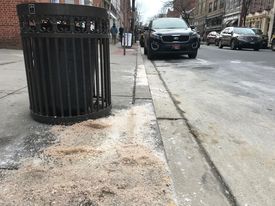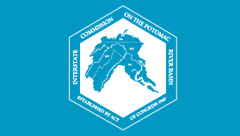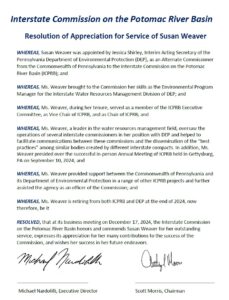Contact
Renee Bourassa, Communications Director
Interstate Commission on the Potomac River Basin
rbourassa@icprb.org | 301.417.4371 | ICPRB





NEWS RELEASE
For Immediate Release
Event Aims to Raise Awareness of the Negative Impacts of Winter Salt
ROCKVILLE, MD (Jan. 23, 202) – The Interstate Commission on the Potomac River Basin, the Northern Virginia Regional Commission, the Izaak Walton League of America Salt Watch Program, the Chesapeake Conservation Landscaping Council, and the Center for Watershed Protection invites the public to learn about winter salt’s impacts on our drinking water, aquatic ecosystems, and infrastructure during the upcoming Winter Salt Awareness Week, January 27-31, 2025.
Winter salt keeps our roads and sidewalks safe, but too much winter salt pollutes our waterways and ends up in our drinking water.
Winter Salt Awareness Week includes a series of webinars featuring speakers and topics focused on the actual cost of winter salt and how to be winter salt smart.

Chloride concentrations have risen almost 10-fold in the past 80 years. (Source: ICPRB)
National speakers include Abby Hileman (Izaak Walton League of America), Jess Hua (University of Wisconsin), Ted Diers (New Hampshire Department of Environmental Services, Cara Hardesty (Ohio Environmental Protection Agency), and Bryan Gruidi (City of Bloomington, Minnesota).
Regional Events
Webinar: Perspectives from the DMV -— A regionally-focused webinar on Wednesday, January 29 at 2:30 pm will feature local speakers Rebecca Murphy (Northern Virginia Regional Commission), Allison Lee (Center for Watershed Protection, Inc.), and Jason Swope (Chesapeake Conservation Landscaping Council). Register in advance or watch the recording on the Salt Wise YouTube Channel. Registrants will receive a calendar invite after registration.
Winter Road Salt Awareness Week Open House — Join the Izaak Walton League of America, Interstate Commission on the Potomac River Basin, and Montgomery County Department of the Environment on Friday, January 31, from 1:00-3:00 pm to monitor the local waterways in Gaithersburg, Maryland, for road salt pollution, and to learn how salt affects our health and freshwater ecosystems, what’s being done, and how we can support local efforts. Members of the media, government officials, nongovernmental organizations, and members of the public are invited to attend. The event is free, but registration is requested.
The Impacts of Too Much Salt
Although salt keeps our roads safe during winter, using more salt than needed comes at a price to our waterways, infrastructure, and drinking water. Winter salt runs off the roads and becomes a permanent pollutant in our waterways. According to the Izaak Walton League of America, only one teaspoon of winter salt permanently pollutes five gallons of water.
Data compiled by the Interstate Commission on the Potomac River Basin shows a 10-fold increase in chloride (a chemical released from the breakdown of winter salt) in the Potomac River at Great Falls over the past 80 years.
There are 28 streams in Maryland considered impaired by chloride and 6 in Virginia.
“Regional and state organizations are working to reduce their winter salt use and improve water quality. Winter Salt Awareness Week is a time to learn more about their important work and give the public the tools to make a difference in their own watershed,” shared Rebecca Murphy, Coastal Program Manager for the Northern Virginia Regional Commission.
“We are seeing an increase in chloride levels in the Potomac River, the source of drinking water to over 5 million people in the D.C. Metropolitan region. Beyond polluting drinking water, it impacts sensitive aquatic life and breaks down infrastructure such as roads and bridges. A bag of salt may be cheap, but nationwide, winter salt costs 5 billion dollars in damage to our infrastructure each year,” said Michael Nardolilli, Executive Director of the Interstate Commission on the Potomac River Basin.
How to be Winter Salt Smart
Follow these steps to protect our waterways:

Only 1 mug of salt is needed for 10 sidewalk squares.
- Shovel first and often. Salt should not be used to melt snow.
- Scatter sparingly: When using salt, scatter it so there are least 3 inches between the grains. A 12-ounce coffee mug of salt is enough to treat an entire 20-foot driveway or 10 sidewalk squares.
- Sweep it up after the storm is over. Reuse it for the next storm.
Learn more on ICPRB’s Winter Salt Smart website.
MD/VA/DC Reduction Efforts
- The Maryland Department of the Environment is piloting a training program for winter maintenance professionals to ensure they maintain safety without overusing winter salt.
- Smart salting training was developed for the District of Columbia’s Snow Team.
- Northern Virginia Regional Commission is implementing the Virginia Salt Management Strategy through ongoing outreach and engagement with private contractors, property owners, and the broader public.
Learn more about regional efforts to protect our waterways at the Perspectives from the DMV Webinar at 2:30 on January 29, 2025.
###
Click here for a PDF of News Release: Event Aims to Raise Awareness of the Negative Impacts of Winter Salt >>>
 How will the recent rain impact chloride levels in our streams and waterways? Why do chloride levels matter? What can the public do to make a difference?
How will the recent rain impact chloride levels in our streams and waterways? Why do chloride levels matter? What can the public do to make a difference?











